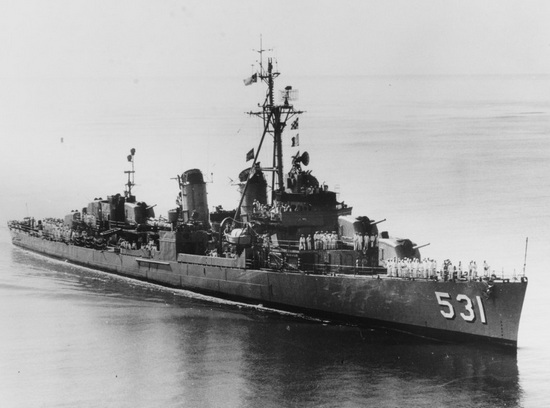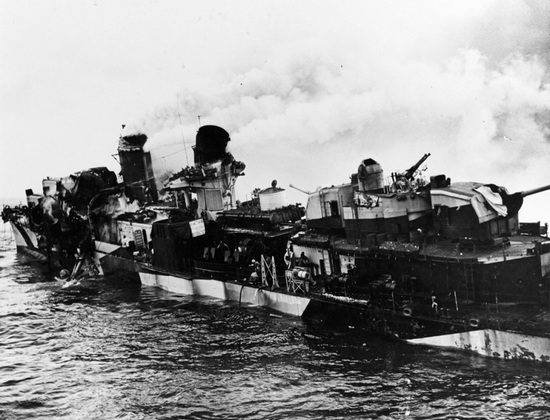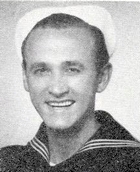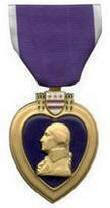Frank Myers
| Date and Place of Birth: | October 24, 1911 Bitumen, PA |
| Date and Place of Death: | April 29, 1945 off Okinawa |
| Baseball Experience: | Minor League |
| Position: | Outfield |
| Rank: | Pharmacist's Mate First Class (PhM1C) |
| Military Unit: | US Navy |
| Area Served: | Pacific Theater of Operations |
Frank M. Myernick, the son of Czechoslovakian
immigrants Stephen and Theresa Myernick, was born in Bitumen,
Pennsylvania on October 24, 1911. By 1914, the family had moved to
Wisconsin, and within two years was living in Mount Morris, Michigan,
with Stephen working as a laborer in the auto industry.
In 1934, 22-year-old Frank Myernick, posing as 19-year-old Frank Myers,
signed with the Pine Bluff Judges of the newly-formed Class C East Dixie
League. A fleet-footed outfielder who could run the bases in under 14
seconds, Myers could also hit, clouting two home runs in his first
professional game against the El Dorado Lions. Myers played 70 games his
rookie year and for reasons that have been lost in time, he joined the
Clarksdale Ginners of the same league in July, returning to the Judges
the following month.
In 1935, Myers hit .306 in 136 games for the Judges. The next year he
played 23 games for Pine Bluff before joining the Greensburg Red Wings
of the Class D Penn State Association in May. In 105 games with
Greensburg, Myers batted .308 and played center field in the Penn State
Association all-star game.
Now 25, but masquerading as a 22-year-old, Myers joined the Rochester
Red Wings of the Class AA International League in 1937,
and played against the Detroit Tigers in a Florida spring exhibition
game in April. Playing alongside future major leaguers Marty
Marion and Johnny Hopp, the jump from Class D to AA was too big for
Myers and he was batting just .129 in 19 regular
season games before being sent to the Union City Greyhounds of
the Class D Kitty League in July. His next stop that season was Decatur
of the Class B Three-I League, where he batted .237 in 27 games, before
joining the Martinsville Manufacturers of the Class D Bi-State League,
batting .301 in 42 games. That proved to be the end of his professional
baseball career, joining the voluntarily retired list in May 1938.
Myernick moved to Detroit after his baseball days and worked for
publishing company, Brown & Bigelow, one of the largest printers of
calendars in the world. Aged 30, he enlisted in the Navy on January 17,
1942, just six weeks after the Pearl Harbor attack. After training he
was assigned, as a Pharmacist's Mate Third Class, to the newly
commissioned Fletcher-class destroyer, USS Hazelwood, on June 18, 1943.
The ever-busy Hazelwood saw action at Tarawa, Wake Island and the
Gilbert Islands in 1943, moving on to the Marshall Islands, Palau, the
Philippines, the Battle of Leyte Gulf in 1944, and Iwo Jima in early
1945. During this time, Myernick was promoted to Pharmacist's Mate
Second Class in December 1943, and Pharmacist's Mate First Class in
September 1944.
In March 1945, the Hazelwood was at Okinawa, providing shore bombardment
for the invasion of the island. After the invasion the Hazelwood
operated off Okinawa on escort patrols through intense Japanese air
attacks. On April 29, 1945, she was attacked by kamikazes who dove out
of low cloud cover. Despite all guns blazing, one kamikaze smashed into
the bridge and exploded, spilling flaming gasoline over the decks and
bulkheads. Ten officers and 67 men were killed or missing in action,
including the Commanding Officer, Commander V. P. Douw, and Pharmacist's
Mate First Class Frank Myernick.
Myernick, aged 33, was buried at sea at 1830 on May 1, 1945, before the
Hazelwood limped to Ulithi in the Caroline Islands on May 5 for
temporary repairs. She then sailed to Mare Island Naval Shipyard,
California via Pearl Harbor for permanent repairs.
Myernick's mother, Theresa, received a wire informing of his death on
May 9, 1945. He is remembered at the Honolulu Memorial in Hawaii and the
Okinawa Peace Memorial.
|
Year |
Team |
League |
Class |
G |
AB |
R |
H |
2B |
3B |
HR |
RBI |
AVG |
| 1934 |
Pine Bluff/ Clarksdale |
E. Dixie | C | 70 | - | - | 75 | 11 | 7 | 5 | - | - |
| 1935 | Pine Bluff | E. Dixie | C | 136 | 487 | - | 149 | 34 | 8 | 2 | - | .306 |
| 1936 | Pine Bluff | Cotton States | C | 23 | 87 | 12 | 23 | 3 | 1 | 0 | 8 | .264 |
| 1936 | Greensburg | Penn State | D | 105 | 403 | 82 | 124 | 21 | 8 | 6 | 58 | .308 |
| 1937 | Rochester | International | AA | 19 | 31 | 4 | 4 | 1 | 0 | 0 | 1 | .129 |
| 1937 | Union City | Kitty | D | - | - | - | - | - | - | - | - | - |
| 1937 | Decatur | Three-I | B | 27 | 93 | 15 | 22 | 7 | 1 | 1 | - | .237 |
| 1937 | Martinsvillle | Bi-State | D | 42 | 163 | 27 | 49 | 7 | 4 | 5 | - | .301 |


Damage to the USS Hazelwood following the kamikaze
attack of April 29, 1945
Date Added September 18, 2023
Thanks to Jack Morris for "discovering" Frank Myers.
Baseball's Greatest Sacrifice is associated with Baseball Almanac
Baseball's Greatest Sacrifice is proud to be sponsored by


